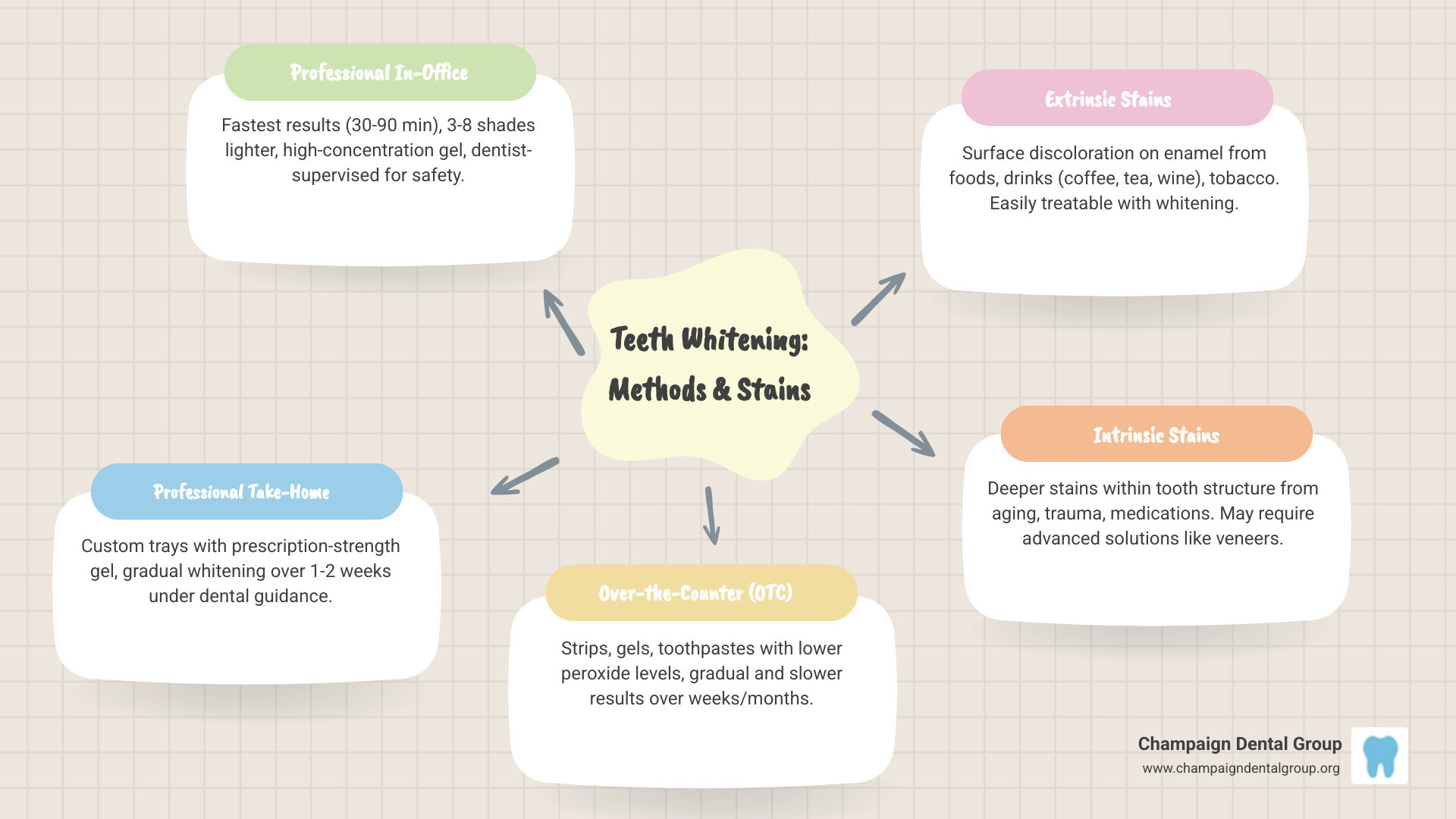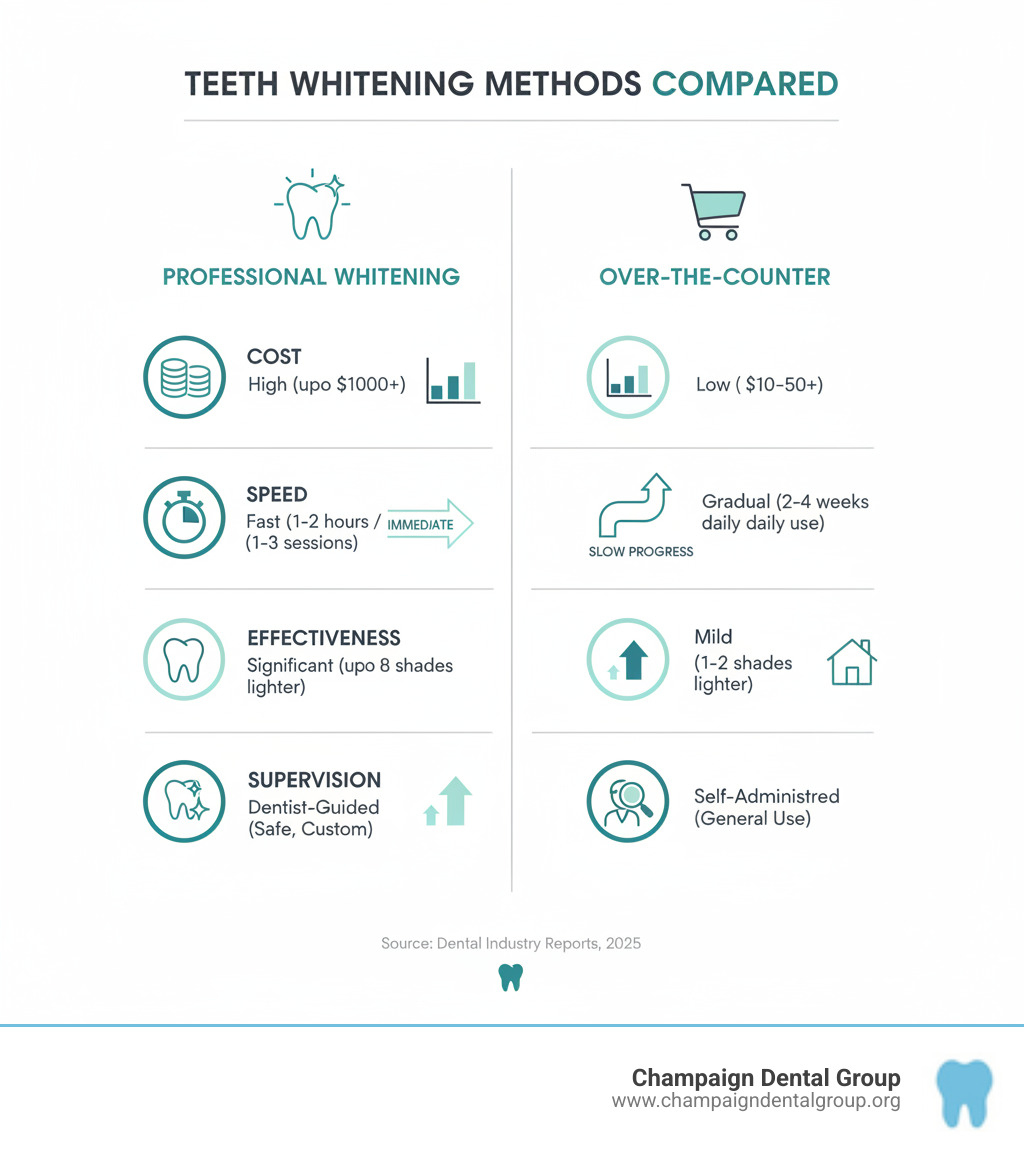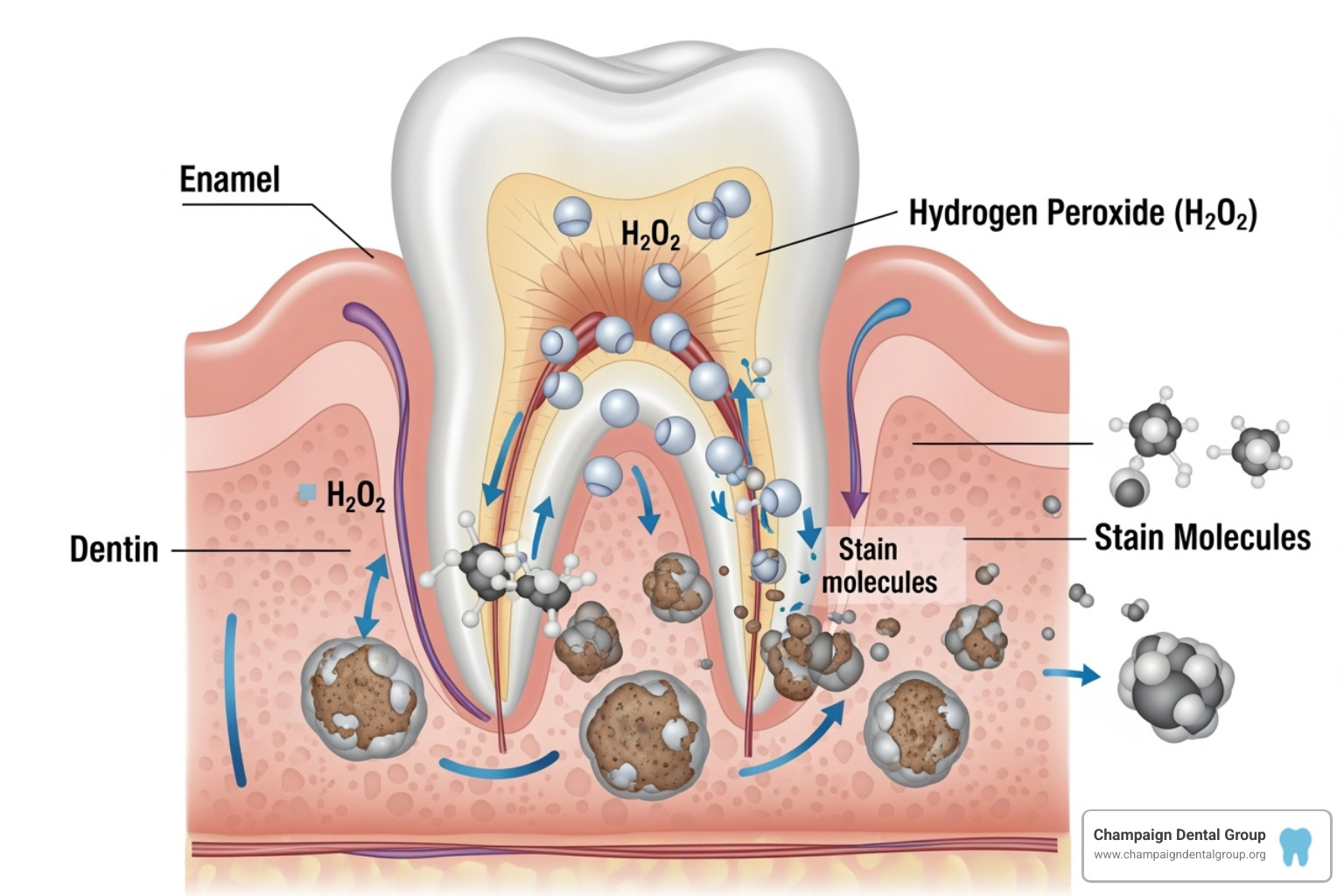How Whitening Methods Can Help You to Choose

Why Understanding Your Teeth Whitening Options Matters
Teeth Whitening Methods offer a path to a brighter, more confident smile, but choosing the right one can feel overwhelming. For busy families making smart healthcare decisions, understanding the options is key.
Here's a quick overview of the main categories:
- Professional In-Office Whitening: The fastest option, delivering results of 3-8 shades lighter in a single 30-90 minute visit under a dentist's supervision.
- Professional Take-Home Kits: Custom trays with prescription-strength gel provide gradual whitening over 1-2 weeks.
- Over-the-Counter (OTC) Products: Strips, gels, and toothpastes with lower peroxide levels offer slower results over weeks or months.
- Porcelain Veneers/Crowns: An alternative for heavily stained teeth that don't respond to traditional bleaching.
Years of coffee, tea, and daily life can dim even the healthiest smile. The right choice depends on your specific goals, budget, and dental health. Professional whitening can lighten teeth up to eight shades, while OTC products typically achieve one to two shades. The biggest difference, however, is safety and supervision.
Before starting any treatment, a dental exam is essential. This ensures your teeth and gums are healthy and helps determine the most effective method for you. At Champaign Dental Group, our experienced team provides personalized guidance, helping families like yours steer these choices with confidence.

Why Do Teeth Get Stained?
Even with regular brushing, teeth can become discolored over time. Understanding the cause is the first step in choosing the right Teeth Whitening Methods. Stains fall into two main categories: extrinsic and intrinsic.
Extrinsic stains are surface-level discolorations on your tooth enamel. These are the easiest to treat and are often caused by:
- Foods and Drinks: Coffee, tea, red wine, dark berries, and tomato-based sauces leave pigments on your enamel.
- Tobacco Use: Tar and nicotine from smoking or chewing tobacco create stubborn yellow and brown stains.
Intrinsic stains develop within the tooth structure, in the enamel or the dentin layer underneath. These are trickier to treat and can result from:
- The Aging Process: Over time, enamel naturally thins while the dentin layer underneath darkens, causing a yellower appearance.
- Trauma: An injury to a tooth can cause internal bleeding and long-lasting discoloration.
- Medications: Certain antibiotics, like tetracycline taken during childhood, can cause significant gray or brown banding on the teeth.
Extrinsic stains usually respond well to most whitening products, while intrinsic stains often require professional treatment or cosmetic alternatives. At Champaign Dental Group, our experienced team identifies the cause of your discoloration to recommend the most effective treatment. This personalized approach is central to the compassionate, high-quality patient care we've provided since 1997. For more on smile improvements, see our guide to cosmetic dentistry.
Comparing Popular Teeth Whitening Methods
With so many Teeth Whitening Methods available, choosing the right one can be confusing. Let's break down the main options to help you make a smart decision for your smile.

As the infographic shows, professional treatments cost more but deliver faster, more dramatic results under expert supervision. OTC products are budget-friendly but work more gradually. The "best" method isn't one-size-fits-all, which is why a consultation with a dentist is absolutely key. At Champaign Dental Group, our compassionate team provides exceptional patient care by creating personalized treatment plans based on your unique dental health, lifestyle, and goals.
Professional Teeth Whitening Methods
For truly impressive results, professional Teeth Whitening Methods are best. These treatments use higher concentrations of whitening agents for more dramatic results in less time, all supervised by experienced dental professionals.
In-office whitening is the fastest way to a brighter smile. A dentist applies a high-concentration peroxide gel (15%-43%) after carefully protecting your gums. The result? Your teeth can become up to eight shades lighter in a single 30-60 minute visit. It's perfect for an upcoming special event. To maintain these results, which can last up to 18 months or longer, we often provide custom-fitted trays for at-home touch-ups. Learn more in our guide to Top Professional Teeth Whitening Techniques 2024: Effective & Safe.
Dentist-supervised at-home whitening kits offer professional results with at-home convenience. We create custom-fitted trays from impressions of your teeth, ensuring the prescription-strength gel makes even contact while protecting your gums. You'll wear the trays for a couple of hours daily or overnight for one to two weeks, achieving significant whitening with typically less sensitivity than in-office treatments. Our Smile Protection Plan can make professional whitening more affordable for your family.
Over-the-Counter (OTC) Teeth Whitening Methods
Drugstore shelves are full of OTC Teeth Whitening Methods that offer convenience and a lower upfront cost. However, they contain weaker whitening agents, so results are more gradual and less dramatic.
- Whitening Toothpastes: These use mild abrasives to scrub away surface stains, lightening teeth by about one shade. They are best for maintenance. Look for the American Dental Association Seal of Acceptance.
- Whitening Strips: These flexible plastic strips are coated with a peroxide gel. Applied daily for about 30 minutes, they can produce full results in 10-14 days that last about four months. Their flat shape can lead to uneven whitening on curved teeth.
- Whitening Gels and Pens: These allow you to brush a peroxide gel directly onto your teeth. They are useful for touch-ups but can be tricky to apply effectively.
- Whitening Rinses: While easy to use, these are the least effective option, as the whitening agents are only in contact with your teeth for a minute or two.
OTC products lack professional supervision, which can lead to uneven results or increased sensitivity. For guidance on safe and effective options, see our article on Safe at Home Teeth Whitening 2024: Effective Methods Revealed.
The Science Behind a Brighter Smile
Ever wonder how Teeth Whitening Methods actually work? The process is a fascinating bit of chemistry that safely transforms your smile.

The magic comes from two bleaching agents: hydrogen peroxide and carbamide peroxide. Hydrogen peroxide is fast-acting and used in most in-office treatments. Carbamide peroxide is a gentler, slower-acting compound found in many take-home kits, which our team at Champaign Dental Group often recommends for gradual, comfortable results.
When applied, these agents release tiny oxygen molecules that penetrate the microscopic pores in your tooth enamel and reach the dentin layer beneath. This triggers a process called oxidation. The stains on your teeth are made of colored organic compounds called chromophores. Oxidation breaks these chromophores down into smaller, colorless particles, effectively erasing the stain and revealing the lighter tooth structure underneath.
This process is safe because it targets only the stain molecules, leaving your natural tooth structure unharmed when used correctly. This is why professional guidance is so important. It's also why whitening doesn't work on dental restorations like crowns or fillings, as they are made of different materials.
Understanding this science empowers you to make a confident choice. At Champaign Dental Group, we combine this proven chemistry with personalized care to help you achieve a bright, healthy smile. For a deeper dive, explore this scientific research on whitening chemistry or our blog post, How Teeth Whitening Works: The Science Behind Brighter Smiles.
Safety, Side Effects, and Candidacy
Is whitening right for you? At Champaign Dental Group, our compassionate team prioritizes your individual health and needs to answer that question. High-quality patient care means ensuring a treatment is both effective and appropriate.
Who is an Ideal Candidate?Whitening works best for individuals with healthy teeth and gums, free from disease. The most dramatic results are seen on yellow-toned stains caused by coffee, tea, or tobacco.
When is Whitening Not Recommended?We advise against whitening in certain situations:
- Pregnancy or Nursing: There is not enough research on the effects on developing babies.
- Children Under 16: Their teeth have larger pulp chambers, making them prone to sensitivity.
- Existing Oral Health Issues: Gum disease, untreated cavities, or infections must be addressed first.
- Worn Enamel or High Sensitivity: Whitening can increase discomfort.
- Dental Restorations: Crowns, veneers, and fillings will not change color, which can create a color mismatch with newly whitened natural teeth.
- Certain Intrinsic Stains: Stains from medications like tetracycline may not respond well to traditional whitening.
Common Side EffectsThe good news is that side effects from Teeth Whitening Methods are typically mild and temporary.
- Tooth Sensitivity: A tingling or sharp twinge, especially to hot or cold, is the most common side effect. It usually subsides within a few days.
- Gum Irritation: The whitening gel can irritate soft tissue if it makes contact, but this also resolves quickly. Our custom-fitted trays and in-office protective measures are designed to prevent this.

Why a Dental Exam Comes FirstA comprehensive dental exam before whitening is essential. It's the foundation for safe, beautiful results. We assess your oral health, identify the cause of staining, and discuss your goals. This personalized approach is what sets Champaign Dental Group apart. Since 1997, we've used state-of-the-art technology and a commitment to exceptional care to create customized treatment plans. If whitening isn't right for you, we'll explore other cosmetic options to give you the confident smile you deserve. Learn more in our comparison of Teeth Whitening Professional vs. At-Home Kits: Which Works Best?.
Making Your Results Last and Exploring Alternatives
You've invested time and effort into brightening your smile with Teeth Whitening Methods—now let's talk about keeping those results as radiant as possible. The longevity of your whiter smile isn't just about the treatment you choose; it's about the daily choices you make afterward.
Professional treatments deliver impressive staying power. When you choose in-office whitening at Champaign Dental Group, you can expect your dramatically brighter smile—up to eight shades lighter—to last up to a year and a half. With diligent care and smart maintenance, some patients enjoy their professional results for up to three years. The secret to maximum persistence? An initial in-office treatment followed by monthly at-home touch-ups using custom trays. This combination approach helps you maintain that confident, camera-ready smile long-term.
Over-the-counter products offer more modest timelines. Results from whitening strips and gels typically fade after about four months, while whitening toothpastes provide subtle, temporary brightening that requires consistent use to maintain.
The difference between results that fade quickly and those that endure often comes down to your daily habits. Practicing excellent oral hygiene is your first line of defense—brushing twice daily, flossing regularly, and rinsing after meals keeps surface stains from taking hold. Mindful eating and drinking makes a significant impact too. Those morning coffees, afternoon teas, and evening glasses of red wine are delicious, but they're also working against your whitening investment. When you do indulge in staining foods and beverages like dark berries or richly colored sauces, try sipping through a straw and rinsing your mouth with water immediately afterward.
If you're a tobacco user, we need to be honest: avoiding tobacco products is essential. Smoking and chewing tobacco will quickly undo even the most dramatic whitening results, leaving you frustrated and your investment wasted. Beyond staining, tobacco use poses serious risks to your overall oral health—something our compassionate team at Champaign Dental Group is always happy to discuss with you.
Regular dental cleanings with our experienced hygienists remove surface stains and plaque buildup that daily brushing might miss. These professional cleanings are like a refresh button for your smile, helping preserve that bright appearance between whitening treatments. Touch-up treatments—whether with custom trays at home or periodic in-office sessions—keep your smile looking its best. Our team will work with you to develop a personalized maintenance schedule that fits your lifestyle and budget, and our Smile Protection Plan can make ongoing care more affordable for your family.
When Traditional Whitening Isn't the Answer
Sometimes, traditional Teeth Whitening Methods simply aren't the right solution. Perhaps you have severe intrinsic staining that doesn't respond to bleaching agents, extensive dental restorations that won't change color, or teeth that are too sensitive for whitening treatments. The good news? You still have excellent options for achieving the beautiful, bright smile you deserve.
Porcelain veneers offer a transformative solution for teeth that are heavily stained, chipped, cracked, or slightly misaligned. These thin, custom-crafted shells bond to the front surface of your teeth, creating a naturally bright, uniform appearance. Veneers are remarkably stain-resistant and, with optimal care, can last 15 years or longer. They're particularly effective for stubborn tetracycline stains or fluorosis that won't respond to conventional whitening.
Dental crowns provide another path to a brighter smile, especially when teeth need structural support in addition to cosmetic improvement. While crowns are often used for restorative purposes—protecting weak or damaged teeth—they also serve as an excellent cosmetic solution for severely discolored or misshapen teeth. A crown completely covers the visible portion of your tooth, giving you a fresh, bright surface that looks completely natural.
At Champaign Dental Group, we understand that every smile is unique, and so are the challenges it faces. Our experienced team uses state-of-the-art technology and genuinely compassionate care to help you explore all your options. Whether you're a candidate for traditional whitening or need an alternative approach, we'll develop a personalized treatment plan that aligns with your goals, your dental health, and your family's budget. For detailed insights into these restorative options, we invite you to read our guide on Cosmetic Dental Surgery: How to Choose Between Veneers vs. Crowns.
Your dream smile is within reach—let's work together to make it last.
Frequently Asked Questions About Teeth Whitening
Our patients often have questions about Teeth Whitening Methods. Here are answers to some of the most common concerns we hear at Champaign Dental Group.
Do natural or DIY whitening methods work?
While social media is full of DIY whitening hacks, most are ineffective and some are even harmful. Here's a quick rundown:
- Baking Soda: As a mild abrasive, it can help remove some surface stains and is found in many ADA-approved toothpastes. However, it won't change the intrinsic color of your teeth. The ADA notes its use in toothpastes.
- Activated Charcoal: This popular trend is highly abrasive and can wear down your enamel over time, potentially making teeth appear darker and more sensitive. There is insufficient evidence to support its safety or effectiveness.
- Fruit Acids (Lemons, Strawberries): The acid in fruit can erode your tooth enamel. This damage is permanent and leads to sensitivity and decay.
- Oil Pulling: There is no scientific evidence that swishing with coconut oil whitens teeth.
For safe and proven results, it's best to stick with professionally recommended methods. For more facts, see MouthHealthy: Natural Teeth Whitening—Fact vs. Fiction.
Can I whiten crowns, veneers, or fillings?
No. This is a crucial point: whitening agents only work on natural tooth structure. Dental restorations like crowns, veneers, and fillings are made from materials that will not change color. Whitening your natural teeth can lead to a noticeable color mismatch. Our skilled team at Champaign Dental Group can help you plan for a uniform, bright smile, which may involve whitening first and then replacing old restorations to match the new shade.
Does teeth whitening damage your enamel?
When used correctly under professional supervision, Teeth Whitening Methods are safe for your enamel. Numerous studies confirm that peroxide-based whitening, used as directed, does not cause permanent damage to enamel or the tooth's nerve. The most common side effects are temporary tooth sensitivity and gum irritation, which are not signs of damage and resolve quickly. Misuse of products can cause issues, which is why professional guidance from our experienced team is so important for protecting your long-term oral health.
Conclusion: Your Path to a Radiant Smile
You're now equipped with the knowledge to choose from the various Teeth Whitening Methods. We've covered fast in-office treatments, convenient take-home kits, and gradual OTC products, as well as alternatives like veneers for more complex cases.
The most important takeaway is that there is no single best solution. The right method depends on your stain type, desired speed, budget, and overall dental health.
This is why partnering with a dental professional is so valuable. At Champaign Dental Group, we've provided compassionate, high-quality patient care to the Champaign and Urbana, OH community since 1997. Our experienced team doesn't believe in one-size-fits-all dentistry. We take the time to understand your goals, perform a thorough exam using state-of-the-art technology, and create a personalized treatment plan that is custom-made for you.
If cost is a concern, ask about our Smile Protection Plan, designed to make professional care more accessible. Your journey to a brighter, more confident smile starts with a conversation. Let's work together to make it happen.
.jpg)